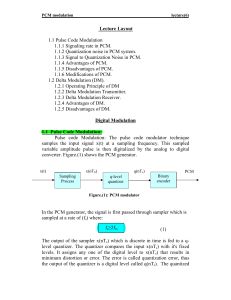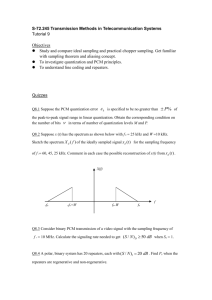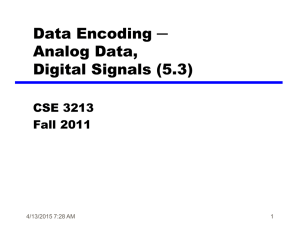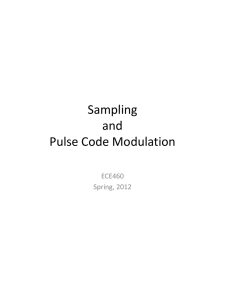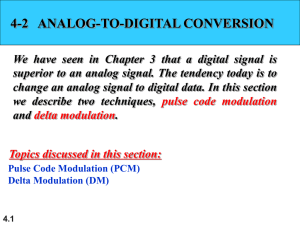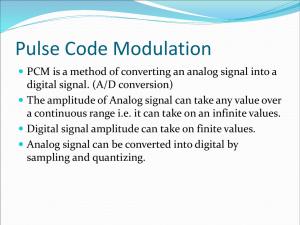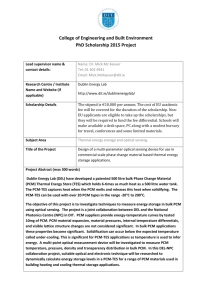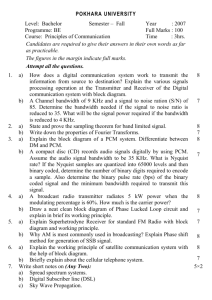Lecture Layout 1.1 Pulse Code Modulation 1.1.1 Signaling rate in
advertisement
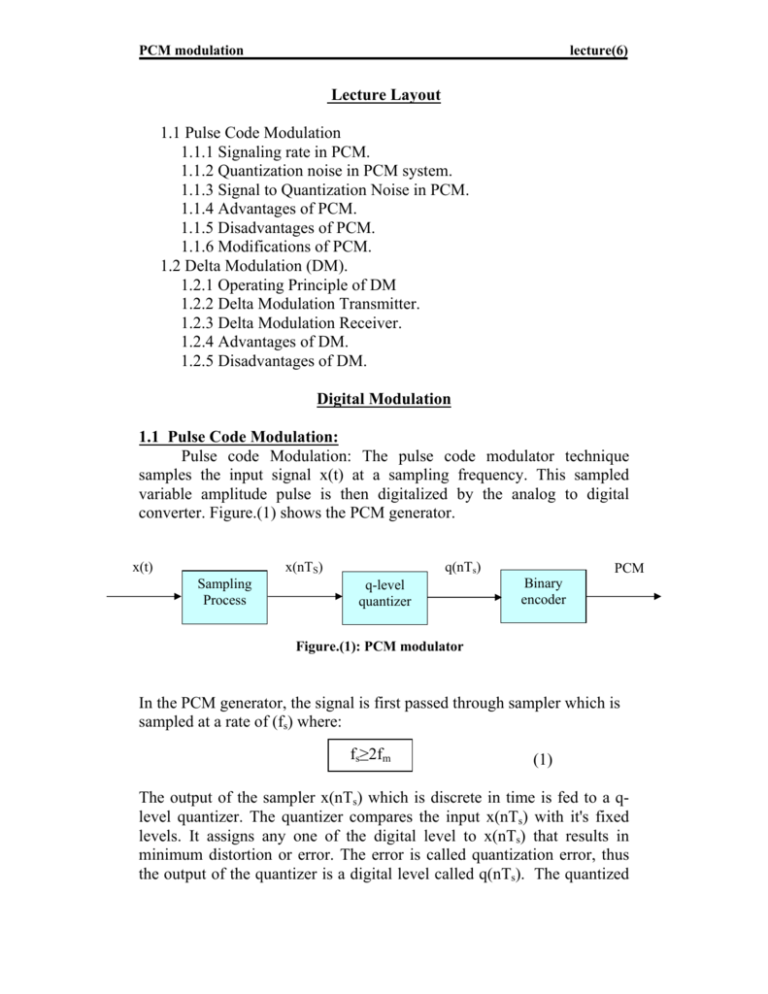
PCM modulation lecture(6) Lecture Layout 1.1 Pulse Code Modulation 1.1.1 Signaling rate in PCM. 1.1.2 Quantization noise in PCM system. 1.1.3 Signal to Quantization Noise in PCM. 1.1.4 Advantages of PCM. 1.1.5 Disadvantages of PCM. 1.1.6 Modifications of PCM. 1.2 Delta Modulation (DM). 1.2.1 Operating Principle of DM 1.2.2 Delta Modulation Transmitter. 1.2.3 Delta Modulation Receiver. 1.2.4 Advantages of DM. 1.2.5 Disadvantages of DM. Digital Modulation 1.1 Pulse Code Modulation: Pulse code Modulation: The pulse code modulator technique samples the input signal x(t) at a sampling frequency. This sampled variable amplitude pulse is then digitalized by the analog to digital converter. Figure.(1) shows the PCM generator. x(t) x(nTS) Sampling Process q(nTs) q-level quantizer Binary encoder PCM Figure.(1): PCM modulator In the PCM generator, the signal is first passed through sampler which is sampled at a rate of (fs) where: fs≥2fm (1) The output of the sampler x(nTs) which is discrete in time is fed to a qlevel quantizer. The quantizer compares the input x(nTs) with it's fixed levels. It assigns any one of the digital level to x(nTs) that results in minimum distortion or error. The error is called quantization error, thus the output of the quantizer is a digital level called q(nTs). The quantized PCM modulation lecture(6) signal level q(nTs) is binary encode. The encoder converts the input signal to v digits binary word. q(nTs) X(t) q6 q5 q4 Quantizing levels q3 q2 q1 q0 nTs Figure.(2) A sampled signal and the quantized levels Figure.(3) shows the block diagram of the PCM receiver. The receiver starts by reshaping the received pulses, removes the noise and then converts the binary bits to analog. The received samples are then filtered by a low pass filter; the cut off frequency is at fc. fc = f m (2) where fm: is the highest frequency component in the original signal. PCM + Noise Binary encoder q(nTs) D/A Converter x(nTS) x(t) Low-pass filter Figure.(3): PCM demodulator It is impossible to reconstruct the original signal x(t) because of the permanent quantization error introduced during quantization at the transmitter. The quantization error can be reduced by the increasing quantization levels. This corresponds to the increase of bits per sample(more information). But increasing bits (v) increases the signaling PCM modulation lecture(6) rate and requires a large transmission bandwidth. The choice of the parameter for the number of quantization levels must be acceptable with the quantization noise (quantization error). Figure.(4) shows the reconstructed signal. q(nTs) q5 q4 X(t) q3 q2 X(nTs) q1 q0 t Figure.(4):The reconstructed signal 1.1.1 Signaling Rate in PCM Let the quantizer use 'v' number of binary digits to represent each level. Then the number of levels that can be represented by v digits will be : q=2v (3) The number of bits per second is given by : (Number of bits per second)=(Number of bits per samples)x(number of samples per second) = v (bits per sample) x fs (samples per second) The number of bits per second is also called signaling rate of PCM and is denoted by 'r': Signaling rate= v fs Where: (4) PCM modulation lecture(6) fs≥ fm Example If the number of binary bits = 3 and the sampling rate is 2 sample/sec find the signaling rate, number of quantization levels? Solution: fs=2, v=3 signaling rate(r) = v fs =3*2 =6 bits/sec Number of quantization(q)=2v =23 =8 levels 1.1.2 Quantization Noise in PCM System Errors are introduced in the signal because of the quantization process. This error is called "quantization error". We define the quantization error as: ε= xq (nTs)- x(nTs) (5) Let an input signal x(nTs) have an amplitude in the range of xmax to - xmax The total amplitude range is : Total amplitude = xmax-(- xmax) =2 xmax If the amplitude range is divided into 'q' levels of quantizer, then the step size '∆'. ∆= 2 X max q (6) If the minimum and maximum values are equal to 1, xmax,=1, - xmax=-1, then the equation (6)will be: ∆= 2 q (7) PCM modulation lecture(6) If ∆ is small it can be assumed that the quantization error is uniformly distributed. The quantization noise is uniformly distributed in the interval [-∆/2, ∆/2 ]. The figure.(5) shows the uniform distribution of quantization noise: fε(ε) 1/∆ -∆/2 ε ∆/2 Fig.(5) The uniform distribution of quantization error The noise power is given by: 2 Noise power = Vnoise /R (8) 2 Vnoise : is the mean square value of noise voltage, since noise is defined by random variable "ε" and PDF fε(ε), it's mean square value is given by : /2 2 noise V 2 f ( ).d (9) / 2 Substitute the value of f ( ) =1/∆ in eq(9): /2 2 noise V 2 1 / .d / 2 3 1 3 3 8 8 2 12 If R=1 PCM modulation lecture(6) 2 Quantization noise power = 12 (10) 1.1.3 Signal to Quantization Noise ratio in PCM The signal to quantization noise ratio is given as: S Nq Normalized signal power Normalized noise power Normalized signal power 2 12 (11) (12) The number of quantization value is equal to: q=2v Putting this value in eq(6), we get: 2 X max 2V Substitute this value in eq(12), we get S Nq Normalized signal power 2 1 2 X max 2 v 12 Let the normalized signal power is equal to P then the signal to quantization noise will be given by: S 3P 2 2 N q X max 2v (13) PCM modulation lecture(6) Examples(2) A signal that has the highest frequency component of 4.2MHz and a peak to peak value of 4 volts is transmitted using a binary PCM. The number of quantization levels is 512 and P=0.04W calculate: 1. Code word length. 2. Bite rate. 3. output signal to quantization noise ratio. Solution: fm=4.2 MHz, q=512 512=2v log 512=v log2 1. length of code word= v=9 bits 2. Bit rate r= v fs = v*(2 fm ) =9*2*4.2MHz =75.6*106 bits/sec 3. S 3 P 2 2v 2 N q X max 3 * 0.04 * 216 = 4 =1966.08 33dB 1.1.4 Advantages of PCM 1. Effect of noise is reduced. 2. PCM permits the use of pulse regeneration. 3. Multiplexing of various PCM signals is possible.
